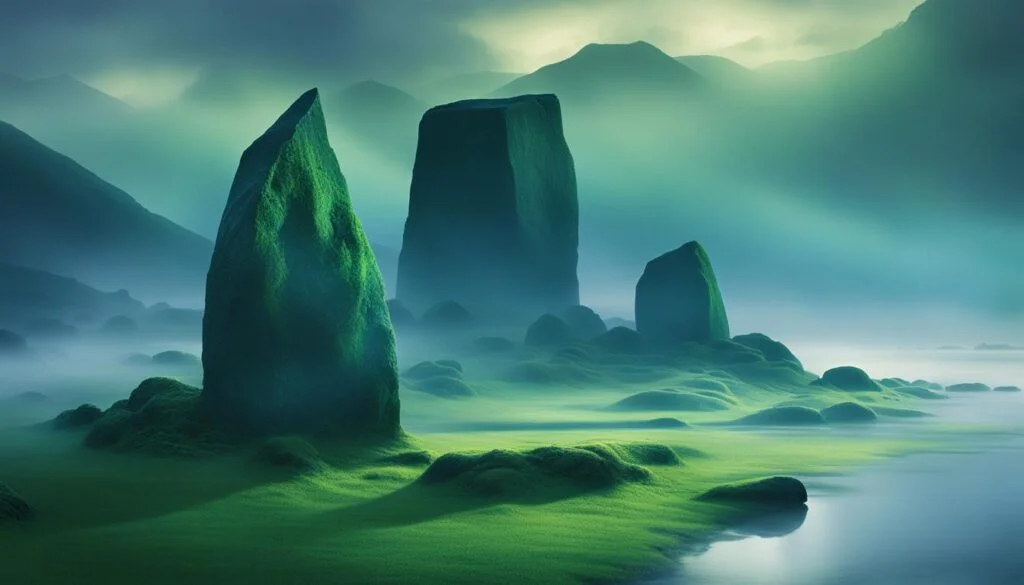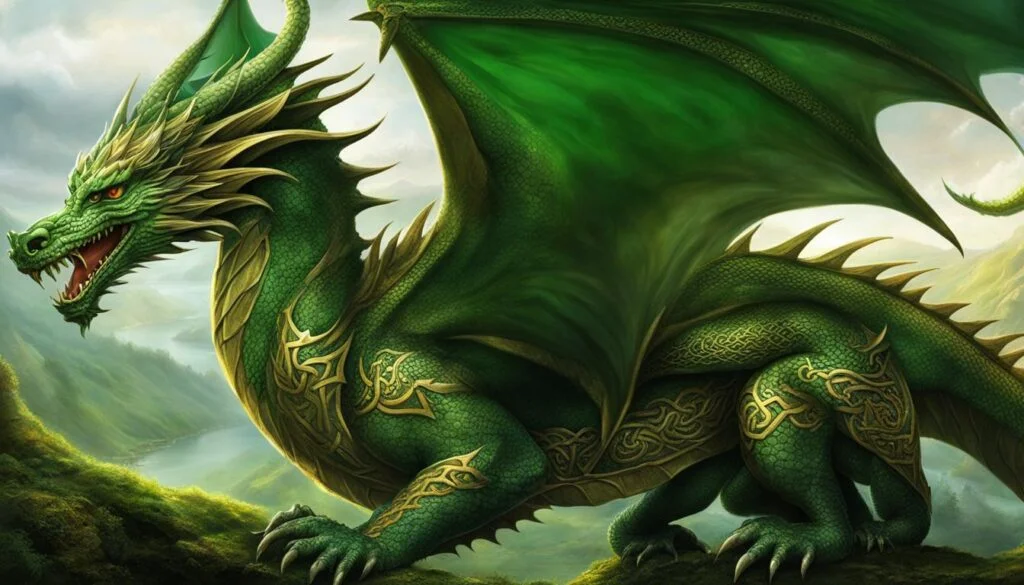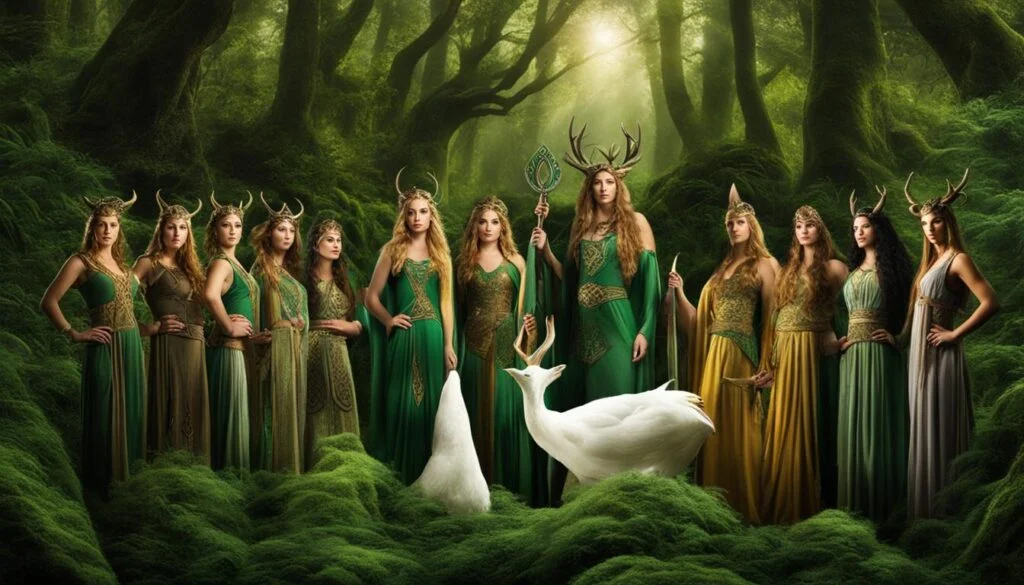Who are the Aos Sí in Irish and Scottish folklore? The Aos Sí, also known as the Sidhe or Aes Síde, are supernatural beings in Celtic mythology. They are often described as the fairy folk or mythical creatures of Irish and Scottish folklore. In both Irish mythology and Scottish mythology, the Aos Sí hold a prominent place, with their stories and legends captivating the imaginations of generations.
The Aos Sí are believed to be the descendants of the Tuatha Dé Danann, the “People of Danu,” and they possess incredible beauty and terrifying abilities. They reside in underground fairy forts, across the Western sea, or in an invisible world that exists alongside the human world. As guardians, they are deeply connected to their abodes and maintain a close relationship with nature.
Key Takeaways:
- The Aos Sí are supernatural beings in Celtic folklore, considered as the fairy folk or mythical creatures of Irish and Scottish traditions.
- The Aos Sí are believed to be descendants of the Tuatha Dé Danann and are known for their beauty and terrifying abilities.
- They live in underground fairy forts, across the Western sea, or in an invisible world that coexists with the human world.
- The Aos Sí are guardians of their abodes and are deeply connected to nature.
- Legends and beliefs surrounding the Aos Sí portray them as otherworldly beings with magical powers who interact with humans.
The Origins and Etymology of Aos Sí
The Aos Sí, mysterious beings in Irish folklore and mythology, have their origins rooted in the ancient tales and legends of Celtic culture. The term “Aos Sí” is derived from the Irish language and translates to “people of the fairy mounds” or “people of the mounds.” In Scottish Gaelic, they are known as “daoine sìth.”
According to ancient Irish mythology, the Aos Sí are believed to be the descendants of the Tuatha Dé Danann, a divine race associated with magical abilities. Their lineage connects them to the pre-Celtic inhabitants of Ireland, and they are considered a distinct race with powers and connections to the netherworld.
The term “Sídhe” refers to the mounds or hills where the Aos Sí are said to dwell. These hills, also known as fairy forts, hold great significance in Celtic folklore. During the Celtic Revival, which was a cultural and artistic movement in the late 19th and early 20th centuries, the term “sidhe” became a loanword in English and was used to refer not only to the mounds but also to the mystical beings who inhabited them.
To get a visual glimpse of the enchanting world of the Aos Sí, take a look at the image below:
Image: seowriting.ai
Legends and Beliefs Surrounding Aos Sí
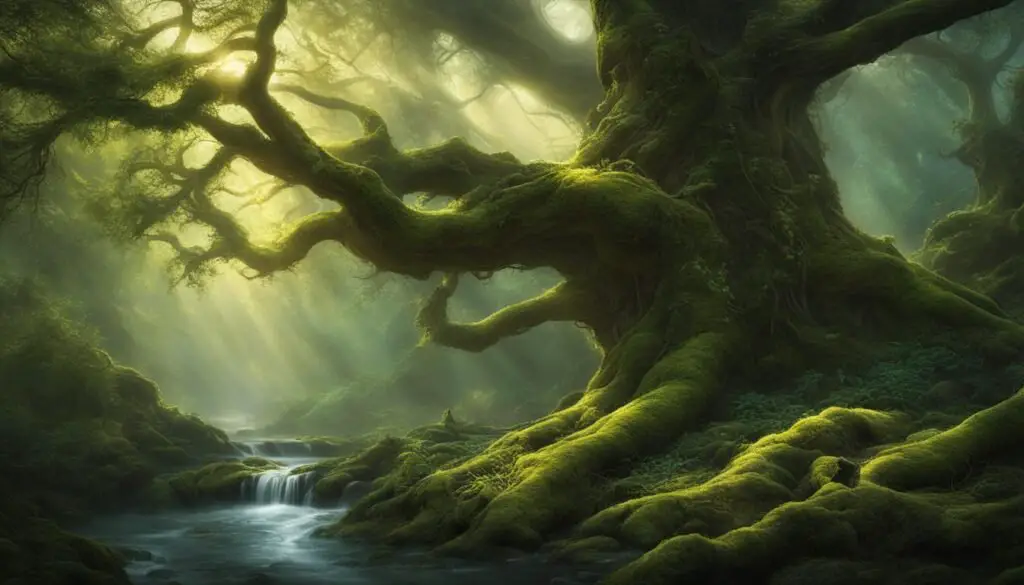
In Irish folklore and mythology, the Aos Sí are fascinating and elusive beings who are deeply ingrained in the fabric of Celtic culture. These otherworldly creatures are believed to possess magical powers and have a profound connection to the supernatural realm. They are often revered as ancestors, spirits of nature, or even gods and goddesses.
According to some legends, the Aos Sí are the survivors of the Tuatha Dé Danann, a divine race that sought refuge in the Otherworld after being defeated by mortal forces. They are said to reside in mystical locations such as fairy hills, fairy rings, and special trees. These enchanting places serve as portals between the human world and the realm of the Aos Sí.
The Aos Sí are both respected and feared by humans. They are known to interact with mortals, offering protection, wisdom, and in some cases, even magical abilities. However, it is crucial to approach them with reverence, as their anger can bring misfortune and curses upon those who disrespect them.
In order to appease the Aos Sí and maintain a harmonious relationship, offerings are often made to honor and respect their presence. Milk, traditional foods, and other cherished items are left at their sacred sites as tokens of gratitude. These offerings are meant to show reverence and seek the favor of these mysterious beings.
Beliefs and Practices
- The Aos Sí are believed to be the guardians of certain locations, such as ancient mounds and sacred groves.
- They possess the ability to shape-shift, appearing in various forms to interact with humans.
- The Aos Sí are associated with fertility, harvests, and the cyclical nature of life.
- They are known to have a fondness for music, dance, and other artistic expressions.
- Some believe that the Aos Sí can manipulate the weather and influence natural phenomena.
These legends and beliefs surrounding the Aos Sí highlight their profound impact on Gaelic mythology and fairy folklore. They continue to captivate the imaginations of both locals and enthusiasts, inspiring a sense of wonder and awe.
Notable Aos Sí in Irish and Scottish Folklore
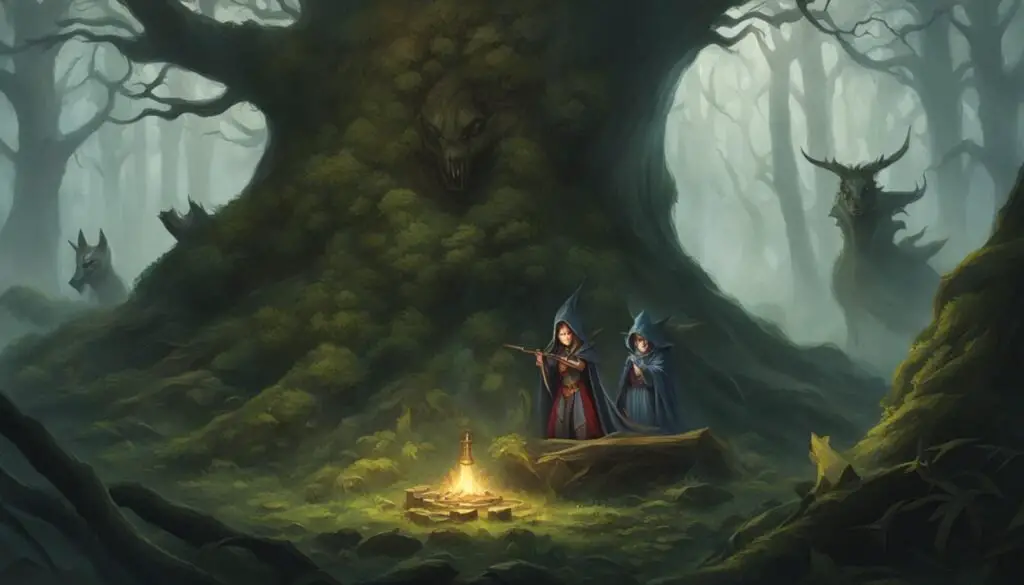
In Irish and Scottish folklore, the Aos Sí are a prominent presence, with several notable beings playing significant roles in myths and legends. These fascinating creatures, deeply rooted in Irish and Scottish mythology and Celtic folklore, have captured the imagination of people for generations.
Bean Sídhe (Banshee)
The Bean Sídhe, also known as the Banshee, is a female spirit associated with announcing imminent death. In Irish mythology, she is often depicted as a ghostly figure wailing and lamenting, foretelling the death of a family member. Her haunting cries are considered an omen of impending doom.
Púca
The Púca is a mischievous shapeshifting creature often appearing as a black horse. It has the ability to transform into various forms, including a goat or a goblin. In Irish mythology, encounters with the Púca are both enchanting and unnerving, as it can be either benevolent or malicious toward humans.
Leannán Sídhe
The Leannán Sídhe, also known as the faery lover, is a captivating Aos Sí who inspires artists and poets. This beautiful and seductive being bestows creativity and inspiration upon those she favors. However, her love comes at a cost, as she drains the life force and energy of her mortal lovers.
Cat Sìth
The Cat Sìth is a fairy cat in Scottish mythology, known for its large size and dark appearance. Legends describe it as a creature capable of stealing the souls of the deceased before the gods can claim them. It is often associated with Samhain, the Gaelic festival that marks the end of the harvest season.
Cu Sìth
The Cu Sìth is a fairy dog in Scottish folklore, known for its massive size and shaggy appearance. It is believed to be a harbinger of death, howling loudly as it passes through the night. Some accounts describe it as a spectral guardian, while others depict it as a more sinister presence.
Sluagh
The Sluagh represents a host of restless spirits in Scottish mythology that soar through the sky. These malevolent entities are believed to be the spirits of the unforgiven dead, often described as a flock of dark birds or a terrifying airborne swarm. They are associated with death, disease, and misfortune.
These notable Aos Sí beings in Irish and Scottish folklore are just a glimpse into the vast tapestry of myths and legends that make up Celtic heritage. Each of them carries its own unique characteristics and captivating stories, further enriching the magical world of the Aos Sí.
Aos Sí and the Human World
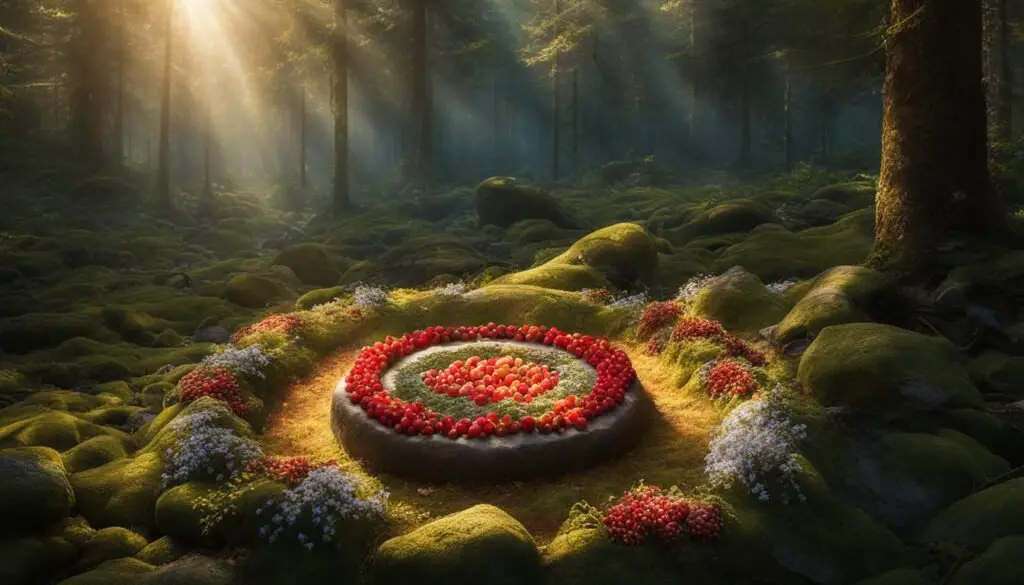
In traditional folk beliefs, there have been numerous interactions between humans and the Aos Sí throughout history. According to folklore, the Aos Sí possess the power to bring protection, healing, and even teach certain skills to mortals. However, it is crucial for humans to treat these supernatural beings with respect and reverence.
Folk beliefs dictate that offerings are often made to appease the Aos Sí. Milk and traditional foods, such as freshly baked goods and succulent berries, are commonly left as offerings at sacred sites and fairy mounds. These offerings are intended to show appreciation and seek goodwill from the Aos Sí.
It is believed that disrupting or disrespecting the Aos Sí’s sacred places, such as fairy hills and ancient trees, can result in curses and misfortunes befalling individuals and their families. Therefore, utmost care must be taken to preserve these natural features and honor the Aos Sí’s connection to the land.
The interactions between humans and the Aos Sí are deeply rooted in folk beliefs, serving as a testament to the intricate relationship between mortals and these mythical creatures. Such beliefs and practices have been passed down through generations, contributing to the rich tapestry of Celtic folklore and cultural heritage.
In the next section, we will explore the fascinating connection between the Aos Sí and nature, delving into their association with the elemental spirits and their role as guardians of the natural world.
Aos Sí and Nature
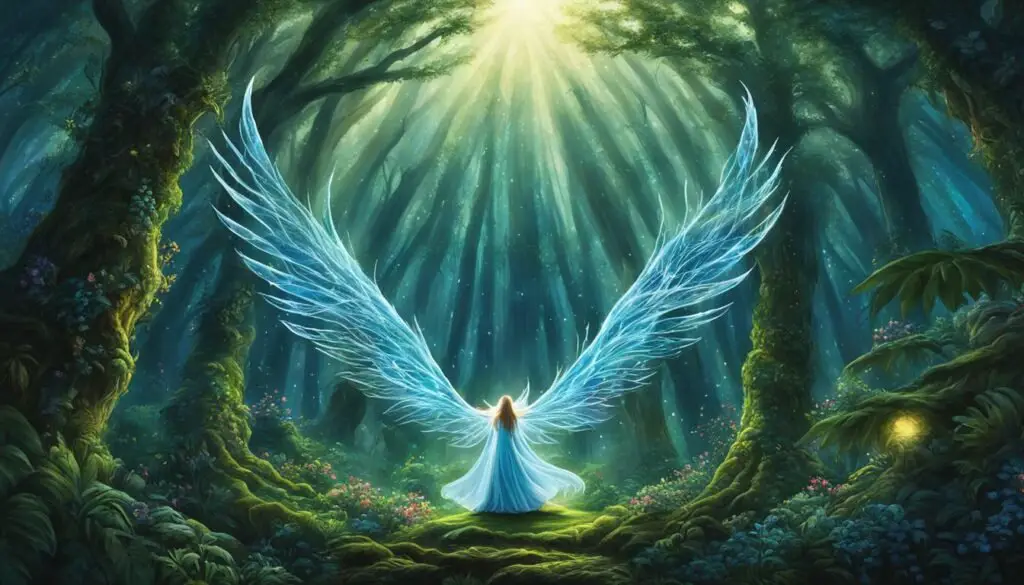
The Aos Sí, also known as the Sidhe or Aes Síde, are not only enigmatic beings but also closely tied to nature. They are believed to be nature spirits, categorized into different types such as wood, water, and air spirits. These elemental beings have a strong connection to their respective elements and are known to possess powers over them.
In the lush landscapes of Ireland and Scotland, many lakes and rivers are said to have guardian Aos Sí associated with them. These guardians not only protect the bodies of water but also ensure the sanctity and balance of the surrounding land.
The Protective Role of Aos Sí
- Wood Spirits: These Aos Sí are closely linked to forests, trees, and woodlands. They act as caretakers, ensuring the well-being of the flora and fauna within their domain.
- Water Spirits: Lakes, rivers, and streams have Aos Sí guardians who oversee the vital element of water. They are believed to possess the power to regulate water levels, provide abundance, and protect aquatic life.
- Air Spirits: The Aos Sí associated with the air have influence over winds, storms, and atmospheric conditions. They are thought to maintain the balance of the air element, providing favorable weather and protecting against destructive forces.
Protected Areas: Fairy Hills and Fairy Rings
Areas considered under the protection of the Aos Sí include fairy hills and fairy rings. Fairy hills, also known as fairy mounds or sidhe mounds, are ancient burial grounds or magical entrances to the Otherworld. Disturbing these sacred places can bring about curses or other forms of retribution.
Fairy rings, on the other hand, are circular patterns of mushrooms or grass that are believed to be gateways or gathering sites for the Aos Sí. These rings are considered sacred spaces and should be treated with respect.
Overall, the Aos Sí maintain a close relationship with nature, acting as custodians and protectors. Through their connection to the elements, they ensure the well-being of the land and its inhabitants, while also reminding humans of the importance of living in harmony with the natural world.
Folklore and Cultural Significance of Aos Sí
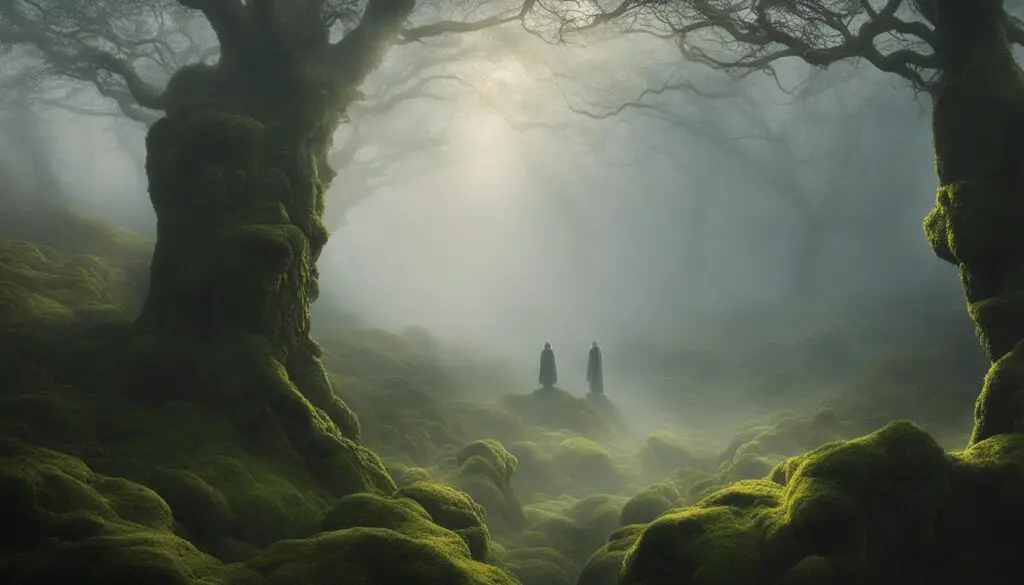
The folklore surrounding the Aos Sí has been deeply ingrained in Celtic culture for centuries. These mythical creatures have played a significant role in shaping the cultural identity of Ireland and Scotland. Their enchanting presence can be found in the rich tapestry of folklore, literature, and art, contributing to the preservation of Celtic heritage and mythology.
The Aos Sí hold a special place in storytelling, music, and other forms of artistic expression. Their enigmatic nature and connection to the supernatural realm continue to captivate and inspire people. In a realm where legends come alive, these mythical creatures remain a testament to the enduring power of myth and folklore.
Through their portrayal in ancient tales and modern adaptations, the Aos Sí have become a symbol of Celtic heritage and cultural significance. Their allure as magical beings and guardians of hidden realms has captured the imagination of both locals and visitors alike.
Intriguing and mysterious, the Aos Sí serve as a source of inspiration for creative minds, impacting not only traditional folklore but also contemporary literature, films, and other forms of popular culture. Their presence in art and storytelling serves as a tribute to their enduring legacy and their deep-rooted connection to the Celtic world.
Modern Interpretations and Popularity
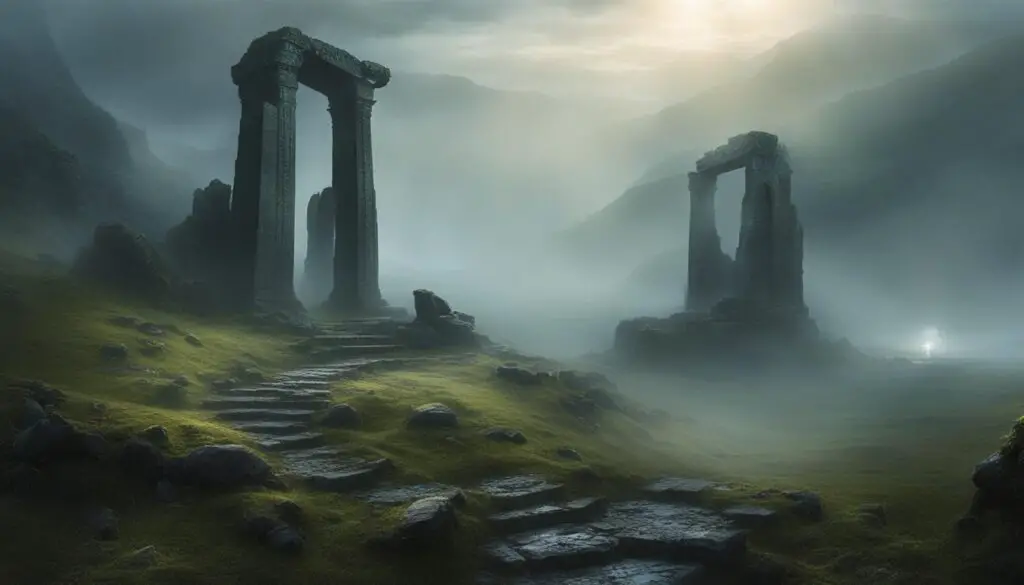
In modern times, the Aos Sí have become beloved figures in literature, film, and popular culture. These enchanting beings are often portrayed as beautiful and magical, with an innate connection to nature and the supernatural.
Artists and storytellers have found endless inspiration in the allure and mystery of the Aos Sí, bringing them to life through vivid portrayals in various art forms. Whether it’s through captivating novels, mesmerizing films, or captivating visual artwork, the Aos Sí continue to capture the imaginations of people around the world.
Many individuals still hold deep-rooted beliefs and practices associated with the Aos Sí. Their influence is felt in the rich folklore and traditions of Ireland and Scotland, where they are celebrated and revered.
As the embodiment of fairy folklore in modern times, the Aos Sí remain a symbol of magic, wonder, and connection to the natural world. Their timeless appeal continues to captivate audiences, serving as a reminder of the enduring power of fairy tales and mythical creatures in our lives.
Modern Interpretations of Aos Sí in Popular Culture
- Novels: Authors like W.B. Yeats, J.R.R. Tolkien, and Patricia Briggs have included Aos Sí characters in their stories, adding depth and intrigue to their narratives.
- Movies: Films such as “Pan’s Labyrinth” and “Hellboy II: The Golden Army” feature captivating interpretations of the Aos Sí, showcasing their ethereal beauty and power.
- Artwork: Visual artists, from illustrators to painters, have depicted the Aos Sí in stunning detail, bringing their enchanting presence to life on canvas or in digital mediums.
Fairy Folklore in Modern Times
- Fairy Festivals: Events like the Fairy Festival in Dublin or the Isle of Skye Fairy Festival celebrate the enduring fascination with fairy folklore, attracting enthusiasts from all over.
- Modern Fairy Beliefs: Many individuals still hold beliefs in fairies and the Aos Sí, leaving offerings or creating fairy gardens as a way to honor these mystical beings.
- Fairy-inspired Fashion and Decor: From fairy-inspired fashion trends to whimsical home decor, the influence of the Aos Sí can be seen in various aspects of modern design and personal style.
Whether through literature, film, or the living traditions seen in fairy festivals, the Aos Sí continue to captivate hearts and minds. Their presence in popular culture ensures that their enchanting legacy will endure for generations to come.
The Legacy of Aos Sí in Celtic Mythology
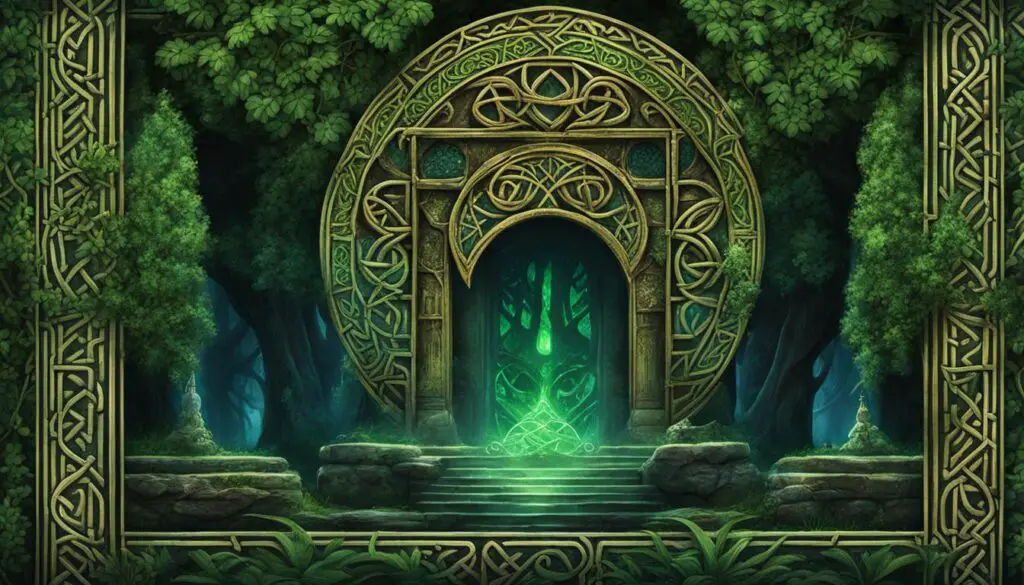
The Aos Sí, with their enchanting presence and captivating abilities, have left a profound legacy in Celtic mythology and folklore. Their influence can be felt in the intricate tapestry of stories, legends, and traditions that have been passed down through generations.
As descendants of the pre-Celtic inhabitants of Ireland, the Aos Sí serve as a connection to ancient times and reflect the heartfelt beliefs, cherished values, and profound cultural identity of the Celtic people. They are woven into the very fabric of Celtic heritage, adding depth and richness to the folklore and shaping the narrative of a mystical world.
Throughout Celtic mythology and folklore, the Aos Sí play various roles, often serving as guardians and protectors of their realms. They possess an innate wisdom that makes them revered teachers, offering lessons and guidance to those who seek their wisdom.
But it is their enigmatic nature that truly fascinates and inspires. The Aos Sí embody the unfathomable mysteries of the supernatural realm, inviting us to explore the depths of Celtic mythology and heritage. Their legacy reminds us of the enduring power of myth and legend, and the indelible marks they have left on Celtic culture and identity.
The Influence of Aos Sí in Storytelling
The legacy of the Aos Sí can be seen in the countless tales and epics that narrate their exploits, adventures, and encounters with humans. From the whimsical folk tales that children grow up with to the epic sagas that captivate the imaginations of adults, the Aos Sí are central characters that breathe life into the stories.
These mythical beings have become an integral part of literary traditions, inspiring renowned authors and poets alike. Their allure and mysterious nature have sparked the creativity of writers, leading to the creation of unforgettable characters and unforgettable tales.
The Aos Sí’s Enduring Significance
The Aos Sí’s enduring significance is not confined to realms of folklore and literature. Their influence can be seen in contemporary art, music, and other forms of artistic expression. Their enigmatic allure continues to captivate and inspire, drawing people closer to their Celtic roots and igniting a sense of pride in their Irish and Scottish heritage.
Conclusion
The Aos Sí, also known as the Sidhe or Aes Síde, are enigmatic beings in Celtic folklore that have intrigued and fascinated people for centuries. As descendants of the pre-Celtic inhabitants of Ireland, they are considered a distinct race with powers and connections to the supernatural realm. Throughout the rich tapestry of Celtic mythology, folklore, and cultural traditions, the Aos Sí have played a significant role in shaping the identity of Ireland and Scotland.
These enigmatic beings are renowned for their beauty, power, and mysterious nature. Their presence continues to captivate and inspire people today, serving as enduring figures in Celtic folklore. The Aos Sí embody the enduring power of myth and legend, reflecting the deep-rooted beliefs and values of the Celtic people.
From their underground fairy forts to their association with nature and their interactions with humans, the Aos Sí have left a lasting legacy in Celtic mythology. Their stories, legends, and traditions serve as a link to ancient times, preserving the rich cultural heritage and igniting the imagination of those who delve into the realms of Celtic folklore.
The Aos Sí stand as testament to the profound connection between humans and the supernatural world. As we continue to explore the enchanting realm of Celtic folklore, their enigmatic presence will forever inspire awe and wonder, reminding us of the enduring power and timeless allure of these magical beings.
FAQ
Who are the Aos Sí in Irish and Scottish folklore?
The Aos Sí, also known as the Sidhe or Aes Síde, are supernatural beings in Celtic mythology, comparable to fairies or elves. They are believed to be descendants of the Tuatha Dé Danann and are known for their beauty and terrifying abilities. In Irish folklore, they are also called daoine sí or people of the fairy mound.
What is the origin of the term Aos Sí?
The term Aos Sí is derived from the Irish language and means “people of the fairy mounds” or “people of the mounds.” In Scottish Gaelic, they are known as daoine sìth. The Aos Sí are believed to be descendants of the Tuatha Dé Danann, a divine race in Irish mythology. The term Sídhe refers to the mounds or hills associated with the Aos Sí.
What is the role of Aos Sí in Irish and Scottish folklore?
In folklore and mythology, the Aos Sí are often portrayed as otherworldly beings with magical powers who interact with humans. They are considered guardians of their abodes and are associated with certain locations such as fairy hills, fairy rings, and special trees. Offerings are often made to appease them and avoid their anger.
Who are some notable Aos Sí in Irish and Scottish folklore?
Some notable Aos Sí in folklore include the Bean Sídhe (Banshee), the Púca, and the Leannán Sídhe. The Bean Sídhe is a female spirit associated with announcing imminent death, the Púca is a shapeshifting creature often appearing as a black horse, and the Leannán Sídhe is a faery lover who inspires artists and poets. Other notable Aos Sí include the Cat Sìth, the Cu Sìth, and the Sluagh.
How do humans interact with the Aos Sí?
Humans and Aos Sí have had interactions throughout history. It is believed that the Aos Sí can offer protection, healing, and teach certain skills to mortals. However, they must be treated with respect and offerings are often made to appease them. Disturbing their sacred places or damaging certain natural features can bring curses upon individuals and their families.
Are the Aos Sí connected to nature?
Yes, the Aos Sí are often associated with nature and are believed to be nature spirits. They have powers over elements such as wood, water, and air. Many lakes and rivers in Ireland and Scotland have guardian Aos Sí associated with them. Fairy hills, fairy rings, and other natural features are considered under their protection, and disturbances may result in curses or other forms of retribution.
What is the cultural significance of the Aos Sí?
The Aos Sí have played a significant role in shaping the cultural identity of Ireland and Scotland. They are deeply rooted in Celtic folklore and continue to be a source of inspiration for storytelling, music, and art. Their presence in myths, legends, and traditions reflects the beliefs and values of the Celtic people, preserving their heritage and mythology.
How are the Aos Sí portrayed in modern times?
The Aos Sí have become popular figures in literature, film, and popular culture. They are often depicted as beautiful, magical beings with a connection to nature and the supernatural. Their enigmatic nature and allure continue to inspire people today, keeping them as enduring and timeless figures in Celtic folklore.
What is the legacy of the Aos Sí in Celtic mythology?
The Aos Sí have left a lasting legacy in Celtic mythology. Their presence and influence can be seen in the rich tapestry of stories, legends, and traditions passed down through generations. They serve as a link to ancient times, reflecting the beliefs, values, and cultural identity of the Celtic people.
Are there any concluding thoughts about the Aos Sí?
The Aos Sí, with their enigmatic nature and connection to the supernatural, are enduring figures in Celtic folklore. Their presence continues to captivate and inspire people, keeping the myths and legends alive and preserving the cultural heritage of Ireland and Scotland.


